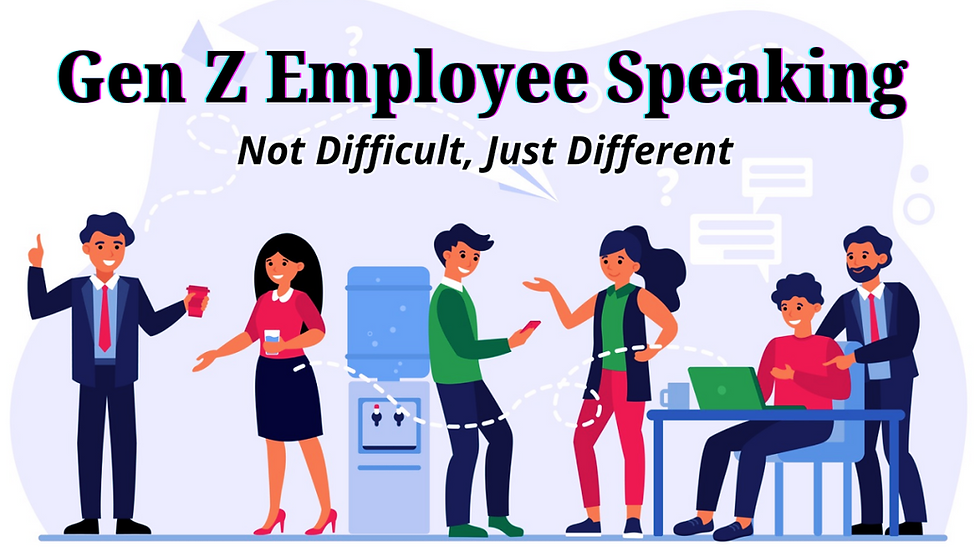From Resistance to Readiness
- Shalaka Rajput
- Jul 26
- 3 min read
Updated: Sep 9

In the past decade, increasing employee productivity has become the heartbeat of today’s workplaces. In India, where competition is fierce, keeping your team engaged isn’t just a perk—it’s essential for survival. After all, more output typically translates to more revenue, which means a better chance at those coveted team outings (or at least a few extra snacks in the break room).
As someone who frequently engages in managerial work, I’ve encountered a fair share of managers grappling with the challenge of keeping employee productivity high. It’s often a delicate balancing act that can feel like trying to juggle while riding a unicycle on a tightrope—one wrong move, and everything could come crashing down.
I’ve watched as managers pour their hearts into motivational speeches that would put a TED Talk to shame, only to be met with blank stares and the sound of crickets. It’s not uncommon for even the most well-meaning managers to feel deflated when their teams seem to be drifting.
Consider the manager who implements team-building exercises, hoping to foster camaraderie, only to find half the team checking their watches, silently wishing they were anywhere else. Or the one who introduces after-work karaoke nights, only to discover that not everyone shares the same enthusiasm for belting out 80s hits.
These experiences underscore the importance of understanding what truly resonates with a team. Finding ways to connect on a personal level, celebrate small wins, and foster an inclusive environment can transform that struggle into success. It’s all about unlocking the potential within each employee and creating a workplace where everyone feels valued—and maybe even a little excited to come to work each day.
Here are some strategies to boost employee motivation and productivity
Hire the Right Fit: Cultural fit is crucial in the hiring process. When employees resonate with the company culture, they can energize their colleagues, much like a well-timed joke at a meeting—lightening the mood and making everyone feel more connected. A thoughtful approach to hiring can ensure a harmonious work environment, rather than a setup for a workplace comedy.
Clearly Define KRAs and KPIs: Key Result Areas (KRAs) and Key Performance Indicators (KPIs) are essential for effective goal-setting. Clearly outlining these objectives helps employees understand expectations, reducing confusion and those delightful “I thought you meant next month” moments—similar to waiting for a train that’s on a completely different schedule.
Show Employees How Valuable They Are: Involving team members in decision-making fosters a sense of ownership. When employees feel their contributions matter—like being invited to contribute to the team’s big presentation—they’re more likely to be engaged and creative. After all, who doesn’t want to feel like the star of their own success story?
Define Clear Career Development Paths: A well-structured career development plan guides employees in their growth, helping them visualize their future within the organization. It’s like having a map for an adventurous road trip: it keeps everyone on track and prevents those “Are we there yet?” moments that can pop up all too frequently.
Implement Better Performance Appraisal Systems: Effective performance measurement helps identify strengths and areas for improvement. Regular feedback sessions can encourage employees to discuss their achievements and growth opportunities, fostering a sense of investment in their roles. Think of it as giving them a friendly nudge, not a shove—no one enjoys a performance review that feels more like a surprise pop quiz!
Prioritize Training: Ongoing training is vital for keeping skills sharp. Just as one might refresh their knowledge of how to fix that one annoying issue on their phone, employees should have opportunities to learn new skills and stay current. Because let’s face it—nobody wants to be the one still using outdated tech, struggling to open an email attachment.
Enhance Employee Engagement: Disengaged employees can negatively impact a company. Cultivating a culture of appreciation—where small wins are celebrated and recognition is given—can transform an ordinary day into something to look forward to, much like finding out you’ve been upgraded to first class on a flight.
Bridge the Generational Gap: In a diverse workforce, it’s important to address differences in thought processes and work styles. Facilitating regular interactions can help align everyone towards common goals, ensuring that all team members work together harmoniously—like a well-rehearsed flash mob that surprises everyone with its synchronicity
However, remember, the journey to boost productivity isn’t about a one-size-fits-all approach; it’s about understanding your team and finding what motivates them. With a bang on approach, managers can transform their teams into motivated powerhouses, ready to tackle challenges and celebrate successes together. After all, a happy team is not just a productive one—it’s also the secret ingredient to a thriving organization.




Comments